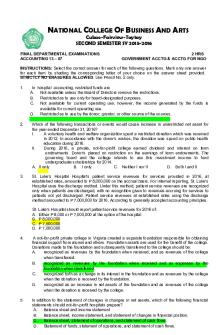2 Introductions - Worksheet that is part of the overall grade PDF

| Title | 2 Introductions - Worksheet that is part of the overall grade |
|---|---|
| Course | Fourth Semester Anishinaabemowin (Ojibwe) |
| Institution | University of Wisconsin-Milwaukee |
| Pages | 2 |
| File Size | 40.8 KB |
| File Type | |
| Total Downloads | 100 |
| Total Views | 141 |
Summary
Worksheet that is part of the overall grade...
Description
Introductions The reason to learn a new language is to use it. Here’s how to greet others and start a conversation. The translation provided below the words is a literal translation that should help you see how Anishinaabemowin and English differ.
Don’t try to turn the sentences around to sound good in English. Start thinking in an Anishinaabe order.
Look for similarity in the center of the action and notice how it changes. o For example: nindonjibaa = I am from onjibaad = he or she is from
gimbakade = you are hungry nimbakade = I am hungry
Practice saying the phrases below without worrying about grammar. Just let the sounds and meaning become more familiar.
The readers here give you a sense of how these words and phrases sound but keep in mind the dialect in your area may be different and every speaker has their own voice, some are soft and careful speakers, others are more emphatic or simply use a faster pace. The most important thing is for you to find your own voice and begin having conversations with a wide range of speakers.
1. Aaniin / Aanii Hi *In the west, people use a final “n” more often than the east. 2. Boozhoo Hello *This is another common, slightly more formal, greeting. 3. Minogizhebaawagad. It’s a good morning. * This is all one word and it reminds us we can see Anishinaabe science in: gizheb (morning), gizhebaa (rotation), giizhig (day) and gizhaade (warm weather). The first speakers of Anishinaabemowin understood that the earth goes around something that creates heat and light. Furthermore, it is clear both the orbit that causes seasons and the rotation that causes day and night were understood.
4. Pat ina gidizhinikaaz? Pat ? you are called? *”ina” makes a sentence a question 5. Enh, Pat nindizhinikaaz. Michigan nindonjibaa. Yes, Pat I am called. Michigan is where I am from originally. 6. Howah! Michigan onjibaa nookomis. Wow! Michigan is where my grandmother is from. 7. Makwa nindoodem. Bear is my clan. *It is common for speakers to ask about your clan in a first conversation. This complex system, based on the animal world, has given Anishinaabe people a way to connect communities and share roles in society for many thousands of years. It is the Anishinaabe custom for people to be part of their father’s clan, but not everyone today knows their clan. Some are adopted into clans and some do considerable research to find their clan. Most importantly, when you meet someone and find out their clan you now know you can’t marry that person! 8. Maang nindibendaagoz. Loon is the one I belong to 9. Gimbakade ina? Are you hungry? 10. Enya, aapiji nimbakade. Yes, very much I am hungry. 11. Ahow, ambe izhaadaa wiisiniwigamigong. Ok, come on let’s go to the restaurant. 12. Wiisinidaa gaye Anishinaabemodaa! Let’s eat and let’s speak Anishinaabemowin!...
Similar Free PDFs

Worksheet 2 - 70% grade
- 3 Pages

Overall Notes
- 46 Pages

2 Son of the Soil - Grade: B
- 9 Pages

The sky is gray - Grade: A
- 4 Pages
Popular Institutions
- Tinajero National High School - Annex
- Politeknik Caltex Riau
- Yokohama City University
- SGT University
- University of Al-Qadisiyah
- Divine Word College of Vigan
- Techniek College Rotterdam
- Universidade de Santiago
- Universiti Teknologi MARA Cawangan Johor Kampus Pasir Gudang
- Poltekkes Kemenkes Yogyakarta
- Baguio City National High School
- Colegio san marcos
- preparatoria uno
- Centro de Bachillerato Tecnológico Industrial y de Servicios No. 107
- Dalian Maritime University
- Quang Trung Secondary School
- Colegio Tecnológico en Informática
- Corporación Regional de Educación Superior
- Grupo CEDVA
- Dar Al Uloom University
- Centro de Estudios Preuniversitarios de la Universidad Nacional de Ingeniería
- 上智大学
- Aakash International School, Nuna Majara
- San Felipe Neri Catholic School
- Kang Chiao International School - New Taipei City
- Misamis Occidental National High School
- Institución Educativa Escuela Normal Juan Ladrilleros
- Kolehiyo ng Pantukan
- Batanes State College
- Instituto Continental
- Sekolah Menengah Kejuruan Kesehatan Kaltara (Tarakan)
- Colegio de La Inmaculada Concepcion - Cebu











